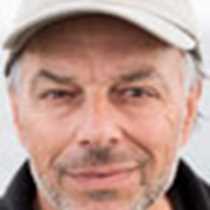The Trip So Far, Part 2. At Sea
Again we traveled in a fog whiteout. Ralph Lee Hopkins did a workshop on photo editing, Melanie Heacox talked about the chemistry of the Antarctic ozone hole, and Eric Guth exposed his passion for ice.
In South Georgia, we found a wild, Lord-of-the-Rings landscape of high-spiring peaks, massive ice, steep rock-and-hummock slopes, howling winds, and shrouding mists. This spectacular scenery comes both highlighted and haunted by seals, penguins, albatrosses, Shackleton’s ghost, and the ghosts of whalers and sealers.
Since leaving the Falklands and all during our South Georgia days, we’ve seen exactly one large whale and two old whaling stations (Stromness and Grytviken). Why that ratio? This answer is from Encyclopedia of Marine Mammals, published by Academic Press: “In 1904, the Norwegian whaler C.F. Larsen arrived at South Georgia and reported with astonishment, ‘I see them in hundreds and thousands.’” But during the next 60 years, “the whaling industry killed approximately two million whales in the southern hemisphere. This included 360,000 blue whales, some 200,000 humpbacks, almost 400,000 sperm whales and a staggering three quarters of a million fin whales.” *
Many of those whales should still be alive. That’s why we haven’t seen more whales.
On South Georgia’s beaches, Southern Elephant Seals got much of our attention. What looks at first like a lot of lounging very soon reveals itself as a hard struggle for existence. Being a male seems particularly unpleasant. Being a female is no bed of roses, either. It seems likely that no one would want to come back in a next life as an elephant seal. During the heyday of whaling, elephant seals were also slaughtered for oil. That killing stopped about 60 years ago, and their populations have been recovering well.
In several places, we enjoyed the proximity of many King Penguins and their big wooly chicks. Salisbury Plain, a particularly stunning part of South Georgia’s generally stunning coast, seemed the Serengeti of penguins. That parent penguins can recognize their own chicks’ voices among large moving mobs is a wonder of evolution and devotion. But everything depends on the fact that they do.
We also got to see many albatrosses. In South Georgia, these included the ethereal Light-mantled Sooty, the exquisite Gray-headed, and the gigantic Wandering Albatross.
“I now belong to a higher cult of mortals, for I have seen the albatross!” exalted the American ornithologist Robert Cushman Murphy during his first trip to the South Atlantic, in 1912. Like us, he eventually found himself on Prion Island. On Prion we had the privilege of visiting as near to a holy shrine as anything in nature: a nesting ground for the Wandering Albatross (probably the only one in the world that tourists can visit).
Wanderers wield the longest wings in nature: up to eleven and a half feet tip-to-tip. During a life spanning perhaps 60 years, they wander literally millions of ocean miles and can stay at sea for years. To feed a chick, they may fly five- to ten-thousand miles and stay at sea for a month to gather enough food for one feeding. They mature at nearly 10 years of age. Courtship takes several years, after which they choose a mate for life. They can lay only one egg in a season. If it breaks, they cannot replace it. A chick requires a year to fledge. Parents cannot breed every year. They have one of the slowest, most extreme life strategies of any living thing.
The solutions that have stabilized declines of other kinds of albatrosses don’t seem to be working for Wanderers. Wandering albatrosses are declining, and this colony has been losing about one percent of its birds each year for over 20 years. Albatrosses of many kinds follow long-lining ships bearing fishing “long-lines” miles long bearing hundreds of baited hooks, trying to snatch bait before the line sinks. Or they follow trawl-net-draggers, whose cables can slice long wings. In these situations, being first can be worst. And, as the biggest of all, Wanderers are often number one in the food line. If there’s trouble to be had, they’re quite at risk.
As on other oceanic islands, whaling ships brought rats to South Georgia. They’ve been devastating to the smaller seabirds. Prion Island is rat-free, and we instantly saw—and heard—the difference in the form of the sweet spring singing of a small, subtle bird that cannot be seen anywhere else on Earth. It’s the world’s southernmost songbird: the South Georgia Pipit.
On our last day visiting South Georgia, at Elsehul’s beach we saw iron cauldrons in which hunters boiled elephant seals for oil. It must have been a miserable time for hunters and hunted, full of blood, pain, and loneliness. Sealers also killed so many fur seals that before 1900 they were believed exterminated. A century later, there are again millions. Is their explosive increase due partly to the lack of whales competing for the same food? One thing it does show: Resilience. Life strives against all odds.
We have made a pilgrimage to one of the world’s most “remote” places. Yet here, ringed by high, wind-bitten slopes, we found ourselves continually in the exquisite, often crowded company of animals who are very much at home. These creatures, our co-voyagers on this ship called Earth, impressed themselves forever into our minds and memories.
*Quoted material from: Clapham , P.J. and Baker, C.S. 2 002. Modern whaling. In: Perrin, W.F., Wursig, B. & Thewissen, J.G .M. (eds.) , Encyclopedia of Marine Mammals, pp. 1328-1332. Academic Press, New York.




